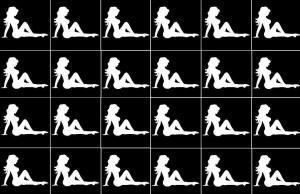This essay first appeared in Cliterati on January 19th; I have modified it slightly for time references and to fit the format of this blog.
 For most of human history, nobody thought of taking money for sex as a defining activity. This is not to say that there were no whores, because of course there were; it isn’t called “the world’s oldest profession” for nothing. But it wasn’t the fact that a woman took money for sex which defined her as a whore, but rather the fact that she made a living from it. As I wrote in my Cato Unbound essay, “Treating Sex Work as Work”,
For most of human history, nobody thought of taking money for sex as a defining activity. This is not to say that there were no whores, because of course there were; it isn’t called “the world’s oldest profession” for nothing. But it wasn’t the fact that a woman took money for sex which defined her as a whore, but rather the fact that she made a living from it. As I wrote in my Cato Unbound essay, “Treating Sex Work as Work”,
…It was almost universally understood that many working-class women and a not-inconsiderable number of those in higher classes would accept money for sex, at least on occasion, and it was impossible to draw a bright, clear line between behaviors that constituted “prostitution” and those (such as concubinage, mistresshood, and political marriage) which did not despite their often-mercenary basis. The manifold laws regulating sex work were not intended to preclude pragmatic motivations for sexual behavior, but rather to keep up appearances, guard the purity of bloodlines, and maintain public order. But as the Victorian Era dawned, a new idea began to take hold of European minds: if science could perfect Man’s tools and techniques, why couldn’t the same process be applied to Mankind itself? The immediate result of turning (pseudo-)scientific inquiry upon sex was that taking money for it was no longer considered merely something that “unladylike” or “sinful” women did for a living or extra income; instead, the “prostitute” was defined into existence as a specific type of woman, separate and distinct from other women.
Prior to the 19th century, any sexual behavior outside of marriage was considered “sinful”, regardless of its motive, but there were also class considerations; sexual “immorality” was both expected and assumed of working-class women, and whether a girl occasionally asked for money or not could make little difference in the way she was perceived by her so-called “betters”. This is why it was not unusual in pre-industrial cultures for a disgraced upper-class woman to turn to sex work; once she had fallen from her elevated station, taking money for sex did no more harm. But once the idea of “prostitution” as some uniquely disgraceful activity was invented, and the “prostitute” was defined as the lowest of the low, it was inevitable that women who would previously have been considered more or less the same as whores would attempt to draw lines between themselves and the new pariah class. And once governments began to criminalize prostitution or activities around it as a result of the new ideas, distinguishing oneself from a “common prostitute” became a matter not only of dignity, but practical necessity.
The first group to successfully shed the whore stigma was actresses, who had since classical times been considered interchangeable with harlots; after the dawn of cinema they actually moved into a de facto higher social class, especially in the United States. Dancers whose style could be credibly represented as asexual or highbrow (preferably both) followed them, then masseuses and women who had extramarital sex for non-financial reasons. In the past several decades, the number of such groups has exploded and now includes many whose claim to being different from sex workers is threadbare indeed; burlesque dancers, competition pole dancers, glamour and lingerie models, professional “cuddlers”, nude maids, waitresses catering to sexual fantasies and even sugar babies insist that they are different from strippers, hookers and fetish workers in some real (and legally defensible) way. Even people who are directly paid for a hands-on sexual service claim that being “certified“ or “spiritual“ or whatever makes them not sex workers, and some who cannot possibly deny that they are still pretend to be “better” than other sex workers because they are “legal”, or because they don’t have direct intercourse and parrot “trafficking” propaganda to kiss up to cops. But this example from the January 15th Guardian takes the biscuit: “As a professional dominatrix, I…[know] sex is a human need, and kink can be a meaningful part of the sexual spectrum. We sex workers turn the erotic into a humane and powerful art. [But] too many of us, particularly escorts, are miserable slaves, and we must fight tirelessly for their freedom…” Way to go there, Margaret Corvid; boost yourself up on the backs of all us pathetic, dirty escorts…oh, excuse me, “miserable slaves”. Because only wonderful, superior dominatrices can choose freely, while those of us who prefer to sell more mundane sexual services are clearly dysfunctional. In my essay “Whorearchy” I wrote,
Way to go there, Margaret Corvid; boost yourself up on the backs of all us pathetic, dirty escorts…oh, excuse me, “miserable slaves”. Because only wonderful, superior dominatrices can choose freely, while those of us who prefer to sell more mundane sexual services are clearly dysfunctional. In my essay “Whorearchy” I wrote,
…a whore is a whore is a whore, and legal, moral or procedural lines serve only to break people into smaller groups which are more easily dominated by the power-hungry. If you accept money from someone that he gives due to sexual interest in you, then you are a whore and everything else is just semantics. When politicians, pundits or rulers use some arbitrary determinant like penetration, duration, location or motivation to bless some harlots while damning others, what they’re actually doing is reducing the size of the group who might oppose them and winning supporters from among those granted legitimacy. This is why I’m harshly unsympathetic to those who vehemently maintain that their species of sex work or sensual therapy is absolutely not prostitution: all they’re doing is throwing other women under the bus, and if we had all stuck together from the beginning of second-wave feminism…prostitution would’ve been decriminalized long ago and many women who are now dead or damaged might still be alive and healthy…
As I’ve pointed out before, gay people only won their civil rights by forming a coalition, and until sex workers stop drawing arbitrary lines between each other and accepting the lies and false divisions promoted by those in power, we will never have the same kind of success.
